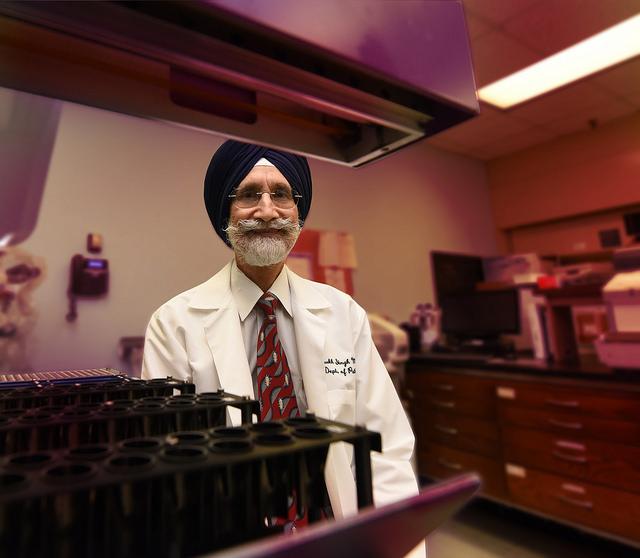
Credit: Phil Jones
AUGUSTA, Ga. (Aug. 10, 2017) – It's a cancer of the plasma cells, which normally make an array of antibodies that protect us from infection.
With multiple myeloma, the cells start primarily producing instead a singular product, called a monoclonal antibody, or M spike, that leaves patients vulnerable for serious infections, like pneumonia, and can even eat away at their bones.
Sophisticated laboratory tests used to both diagnose the disease then follow treatment response, can send confusing messages to patients and their physicians, particularly after stem cell therapy to try to restore a healthy antibody mix, says Dr. Gurmukh Singh. Singh, vice chair of clinical affairs for the Department of Pathology and Walter L. Shepeard Chair in Clinical Pathology at the Medical College of Georgia at Augusta University, is corresponding author of the study highlighting reasons for potential confusion in the Journal of Clinical Medicine Research.
The tests, serum protein electrophoresis and serum immunofixation electrophoresis, or SPEP/SIFE, and serum free light chain assay, or SFLCA, separate proteins into groups according to their electrical charge.
The M spike stands out as a distinctive, dense band of color among the layers of protein groups, while typical antibody levels create bands of lighter smears.
But after stem cell therapy, which first destroys cancerous plasma cells then restores healthy ones, follow up profiles often yield a lineup of antibodies — called an oligoclonal pattern — that can look eerily similar to the M spike.
The confusion comes because there again may be a prominent and likely short-lived band of proteins that emerges as the antibody mix begins, ideally, to normalize.
"We want to emphasize that oligoclonal bands should mostly be recognized as a response to treatment and not be mistaken as a recurrence of the original tumor," Singh says.
The key clarifier appears to be the location of the malignant, monoclonal spike when the diagnosis is made compared to the location of new spikes that may show up after stem cell therapy in these oligoclonal bands, says Singh.
"If the original peak was at location A, now the peak is location B, that allows us to determine that it is not the same abnormal, malignant antibody," Singh says, pointing toward different before and after treatment profiles on a patient.
Normally antibodies spread out in a usual sequence in these studies. "If it's in a different location, it's not the same protein," reiterates Singh. "If the location is different, this is just a normal response of recovery of the bone marrow that could be mistaken for recurrence of the disease," Singh says of the oligoclonal bands that can also temporarily show up in response to an infection.
He notes while the prominent bands are typically short-lived following treatment, the recognition that they are non-malignant may occur only in retrospect.
For the study, Singh and his team looked at lab and clinical data on 251 patients with multiple myeloma treated from January 2010 to December 2016; 159 of those patients received autologous stem cell transplants. Each patient had at least three tests, and at least two of the tests were following their transplant.
They found the incidence of oligoclonal patterns was significantly higher in patients who had a stem cell transplant than the patients who had chemotherapy alone: 57.9 percent compared to 8.8 percent. Only five of the 159 patients who received a transplant had an oligoclonal pattern before treatment but 92 had one afterward. More than half of the the oligoconal patterns developed within the first year following a transplant. The earliest pattern was detected at two months – as soon as the first post-transplant tests were done — and a few occurred as long as five years later.
Autologous stem cell therapy is not considered curative for most patients with multiple myeloma. There is no clear cause of the disease but the risk does increase at age 40, Singh says.
###
Media Contact
Toni Baker
[email protected]
706-721-4421
@MCG_AUG
http://www.augusta.edu/mcg/





